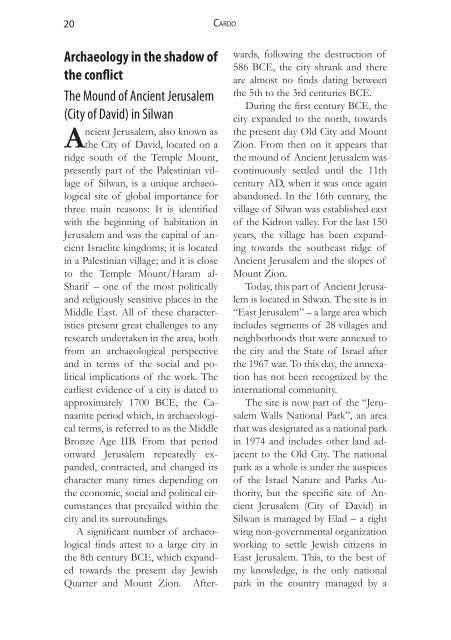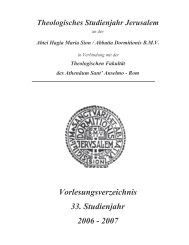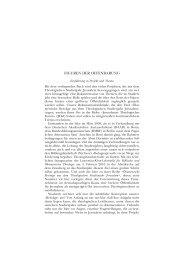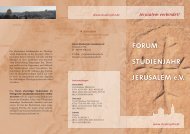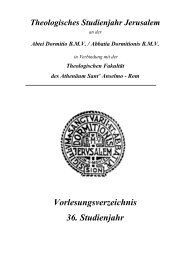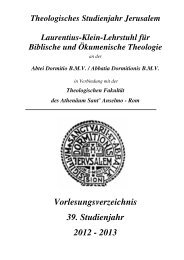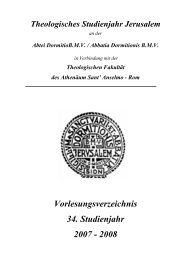Mit Bibel und Spaten? - Theologisches Studienjahr Jerusalem
Mit Bibel und Spaten? - Theologisches Studienjahr Jerusalem
Mit Bibel und Spaten? - Theologisches Studienjahr Jerusalem
Erfolgreiche ePaper selbst erstellen
Machen Sie aus Ihren PDF Publikationen ein blätterbares Flipbook mit unserer einzigartigen Google optimierten e-Paper Software.
20<br />
Archaeology in the shadow of<br />
the conflict<br />
The Mo<strong>und</strong> of Ancient <strong>Jerusalem</strong><br />
(City of David) in Silwan<br />
ncient <strong>Jerusalem</strong>, also known as<br />
A the City of David, located on a<br />
ridge south of the Temple Mount,<br />
presently part of the Palestinian village<br />
of Silwan, is a unique archaeological<br />
site of global importance for<br />
three main reasons: It is identified<br />
with the beginning of habitation in<br />
<strong>Jerusalem</strong> and was the capital of ancient<br />
Israelite kingdoms; it is located<br />
in a Palestinian village; and it is close<br />
to the Temple Mount/Haram al-<br />
Sharif – one of the most politically<br />
and religiously sensitive places in the<br />
Middle East. All of these characteristics<br />
present great challenges to any<br />
research <strong>und</strong>ertaken in the area, both<br />
from an archaeological perspective<br />
and in terms of the social and political<br />
implications of the work. The<br />
earliest evidence of a city is dated to<br />
approximately 1700 BCE, the Canaanite<br />
period which, in archaeological<br />
terms, is referred to as the Middle<br />
Bronze Age IIB. From that period<br />
onward <strong>Jerusalem</strong> repeatedly expanded,<br />
contracted, and changed its<br />
character many times depending on<br />
the economic, social and political circumstances<br />
that prevailed within the<br />
city and its surro<strong>und</strong>ings.<br />
A significant number of archaeological<br />
finds attest to a large city in<br />
the 8th century BCE, which expanded<br />
towards the present day Jewish<br />
Quarter and Mount Zion. After-<br />
Cardo<br />
wards, following the destruction of<br />
586 BCE, the city shrank and there<br />
are almost no finds dating between<br />
the 5th to the 3rd centuries BCE.<br />
During the first century BCE, the<br />
city expanded to the north, towards<br />
the present day Old City and Mount<br />
Zion. From then on it appears that<br />
the mo<strong>und</strong> of Ancient <strong>Jerusalem</strong> was<br />
continuously settled until the 11th<br />
century AD, when it was once again<br />
abandoned. In the 16th century, the<br />
village of Silwan was established east<br />
of the Kidron valley. For the last 150<br />
years, the village has been expanding<br />
towards the southeast ridge of<br />
Ancient <strong>Jerusalem</strong> and the slopes of<br />
Mount Zion.<br />
Today, this part of Ancient <strong>Jerusalem</strong><br />
is located in Silwan. The site is in<br />
“East <strong>Jerusalem</strong>” – a large area which<br />
includes segments of 28 villages and<br />
neighborhoods that were annexed to<br />
the city and the State of Israel after<br />
the 1967 war. To this day, the annexation<br />
has not been recognized by the<br />
international community.<br />
The site is now part of the “<strong>Jerusalem</strong><br />
Walls National Park”, an area<br />
that was designated as a national park<br />
in 1974 and includes other land adjacent<br />
to the Old City. The national<br />
park as a whole is <strong>und</strong>er the auspices<br />
of the Israel Nature and Parks Authority,<br />
but the specific site of Ancient<br />
<strong>Jerusalem</strong> (City of David) in<br />
Silwan is managed by Elad – a right<br />
wing non-governmental organization<br />
working to settle Jewish citizens in<br />
East <strong>Jerusalem</strong>. This, to the best of<br />
my knowledge, is the only national<br />
park in the country managed by a


